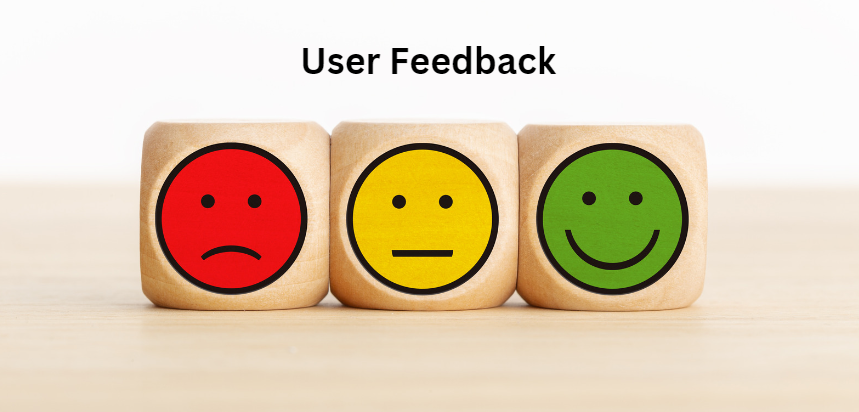
The Untapped Potential of User Feedback in Conversion Optimization
In the dynamic world of e-commerce and digital marketing, leveraging user feedback is akin to discovering a goldmine of insights. This valuable feedback, often overlooked, is a powerful tool for enhancing customer satisfaction and, subsequently, improving conversion rates.
At the heart of a successful marketing strategy lies the ability to understand and cater to the needs of potential customers. User-generated content, such as product reviews and customer feedback, offers a treasure trove of valuable insights. These insights, drawn from both positive and negative reviews, provide a direct line to the customer’s thoughts and experiences.
By tuning into this feedback, businesses can make data-driven decisions, shaping their customer journey to align with the expectations and desires of their current customers and future buyers.
Conversion Rate Optimization (CRO) isn’t just about the numbers; it’s about the people behind those numbers. Each piece of customer feedback, whether it’s a five-star rating or a detailed account of a negative experience, serves as a crucial step in understanding and enhancing the user experience.
The journey of a satisfied customer doesn’t end with a purchase; it extends to how they interact with the product and their likelihood of becoming loyal customers.
A well-crafted Customer Review Strategy should not only focus on gathering positive feedback but also on addressing negative reviews. This iterative process is vital for continuous improvement, ensuring that each customer, whether they are happy customers or unhappy ones, feels heard and valued. Such an approach not only fosters customer loyalty but also transforms casual browsers into potential buyers.
In the realm of marketing efforts, neglecting user feedback is like leaving a crucial component out of your product development process. Engaging with this feedback – from the initial stages of product roadmap planning to the final stages of launching higher-priced or lower-priced products – ensures that your offerings resonate with your customer base.
This approach is a cornerstone of Lean Customer Development, where customer sentiments and suggestions drive product improvements.
To conclude, the impact of customer reviews on conversions cannot be overstated. In a market where customer trust and satisfaction are paramount, leveraging user feedback is not just a marketing strategy; it’s a fundamental aspect of building and maintaining strong customer relationships.
Businesses that embrace this feedback-driven approach are poised to make informed business decisions, ultimately leading to improved conversions and a loyal customer base.
Decoding User Feedback: More Than Just Opinions
Understanding the Depth and Value of User Feedback
In the complex landscape of Conversion Rate Optimization, comprehending the depth and value of user feedback extends beyond collecting mere opinions. It’s about delving into the detailed experiences and expectations of your customer base, whether they are potential clients, current customers, or even those who are not entirely satisfied. This deep understanding is pivotal in refining your product offerings and fine-tuning your marketing strategy.
Qualitative Feedback: The Narrative Behind the Numbers
Qualitative feedback is the rich, narrative layer of customer insight. Typically gathered through open-ended questions in surveys, email campaigns, or interactions on social media platforms, this type of feedback offers detailed insights into the customer’s experience. It’s about understanding the ‘why’ behind customer sentiments and uncovering the reasons behind their reactions to your product or marketing efforts. Whether it’s feedback from regular users or responses from high-paying clients, qualitative feedback provides a narrative that numerical data alone cannot offer.
Quantitative Feedback: The Power of Data
In contrast, quantitative feedback provides a high-level view of customer sentiment through measurable data. It’s the numerical evidence of customer behavior and preferences, often collected via feedback forms, customer surveys, or analysis of product usage patterns. This feedback type is crucial for actionable insights, offering a clear picture of trends and patterns. Metrics like customer effort scores, average ratings, and conversion rates are invaluable in making data-driven decisions and understanding the broader customer sentiment.
Integrating Both Feedback Types for a Comprehensive View
To maximize the effectiveness of a Customer Review Strategy, it’s essential to integrate both qualitative and quantitative feedback. While qualitative feedback offers a detailed understanding of the customer journey, highlighting the emotional and experiential aspects, quantitative feedback provides the statistical evidence needed for informed decision-making. Together, they form a comprehensive view, enabling businesses to effectively leverage user feedback in their conversion optimization process.
Strategies for Effectively Leveraging User Feedback for Conversion Enhancement
Best Practices for Collecting User Feedback
In the realm of Conversion Rate Optimization, the collection of user feedback is not just a task; it’s an art. The first step in leveraging this feedback effectively is ensuring that it’s collected in a manner that is both comprehensive and customer-centric.
This involves employing a variety of methods to gather insights from a wide spectrum of your customer base, including first-time buyers, regular users, and even those who have had a negative experience.
One effective technique is utilizing feedback forms on your website or in your email campaigns. These forms should be designed to capture both qualitative and quantitative feedback, providing a balanced view of customer opinions.
Additionally, actively encouraging product reviews on your website and social media platforms can yield a wealth of user-generated content. This not only helps in gathering valuable feedback but also boosts customer engagement and loyalty.
Another essential practice is to segment your feedback. Different segments of your customer base, such as high-paying customers or potential consumers, may have varying needs and perspectives. By segmenting the feedback, you can tailor your responses and strategies to suit different customer groups, ensuring more targeted and effective conversion optimization efforts.
Integrating Feedback into the Conversion Optimization Process
Once you have collected a robust set of feedback, the next crucial step is integrating these insights into your conversion optimization process. This involves a series of strategic actions, each aimed at enhancing the customer experience and journey based on the feedback received.
Firstly, it’s essential to analyze the feedback for common themes and patterns. Look for insights related to customer frustrations, expectations, and experiences. This analysis will help you identify areas of your product or service that need improvement or where customer experience can be enhanced.
Following this, implement feedback-driven improvements. This could involve making changes to your website’s user interface based on user experience feedback, adjusting your product offerings based on customer suggestions, or even revamping your marketing strategy to better align with customer preferences.
Another key aspect is to close the feedback loop. This means communicating back to your customers about the changes you’ve made based on their feedback. Such communication can take the form of email updates, posts on social media channels, or updates on your website. This not only shows your customers that you value their input but also fosters a positive relationship and builds customer trust.
Finally, continually monitor the impact of these changes on your conversion rates. Use metrics such as customer satisfaction scores, conversion rates, and repeat purchase rates to gauge the effectiveness of your feedback-driven strategies. This ongoing evaluation will help you refine your approach and make more informed decisions in your future marketing efforts.
Tools and Technologies: Harnessing Digital Solutions for Feedback Analysis
Embracing Modern Solutions for Feedback Collection
In today’s digital era, leveraging the right tools and technologies is paramount for effectively collecting and analyzing user feedback. These digital solutions offer a streamlined, efficient way to gather insights, making it easier for businesses to understand and respond to their customer base.
One of the key tools in this arsenal is customer feedback software. These platforms are designed to capture feedback across various channels, including social media platforms, email campaigns, and your website. They offer features like automated surveys, feedback forms, and real-time analytics, providing businesses with a comprehensive view of customer opinions and experiences. Additionally, these tools often include capabilities for segmenting responses, allowing for more targeted analysis and action.
Another significant technology is analytics and data analysis software. These solutions help businesses dive deep into their feedback data, uncovering patterns and trends that might not be immediately apparent. They enable companies to make data-driven decisions, turning a collection of individual opinions into actionable insights.
By harnessing these digital tools, businesses can transform their approach to user feedback, moving from a reactive stance to a proactive strategy in their conversion optimization efforts.
Overcoming Challenges: Addressing Common Hurdles in Feedback Utilization
Navigating the Complexities of Feedback Analysis
While the collection and analysis of user feedback are crucial, they come with their own set of challenges. One common hurdle is the sheer volume of feedback, which can be overwhelming for businesses, especially those without the necessary tools or expertise. This challenge can be mitigated by using advanced data analysis tools, which can efficiently sort through large quantities of data and highlight the most relevant insights.
Another challenge lies in interpreting the feedback accurately. Sometimes, customer opinions can be subjective or influenced by external factors. To overcome this, it’s essential to look for common themes and patterns in the feedback, rather than focusing on individual responses. Employing a combination of qualitative and quantitative analysis can provide a more balanced and accurate understanding of customer sentiment.
Finally, turning feedback into actionable strategies is often easier said than done. It requires not only a deep understanding of the feedback but also the ability to integrate these insights into the existing business model and processes. This can be achieved through a continuous improvement cycle, where feedback is regularly collected, analyzed, and then used to inform business decisions and strategies.
By addressing these challenges head-on, businesses can effectively leverage user feedback to enhance their conversion rates, ensuring a continuous cycle of improvement and customer satisfaction.
Future Trends: Predicting the Evolution of User Feedback in Conversion Strategies
Anticipating the Next Wave in Feedback Utilization
As we look toward the future, the role of user feedback in conversion strategies is poised to become even more significant. With advancements in technology and shifts in consumer behavior, we can anticipate several key trends that will shape the way businesses collect and leverage user feedback.
One major trend is the increasing use of artificial intelligence and machine learning in analyzing feedback. These technologies offer the potential to process vast amounts of data more efficiently, providing deeper insights and predictive analytics. This could mean more personalized user experiences and more targeted conversion strategies.
Another trend is the growing importance of real-time feedback. In an age where customer expectations are continually evolving, the ability to gather and respond to feedback in real-time will become crucial. This could involve more interactive forms of feedback collection, such as live chats and instant feedback mechanisms on digital platforms.
Furthermore, the integration of user feedback into larger data ecosystems is likely to increase. By combining user feedback with other data sources, such as purchase history or website analytics, businesses will be able to create a more holistic view of their customer journey and make more informed decisions.
Crafting a User-Centric Approach for Conversion Success
Key Takeaways and Encouraging Further Exploration
In conclusion, leveraging user feedback is not just a tactic; it’s an essential component of a successful conversion strategy. From understanding the depth and value of feedback to effectively integrating it into your business processes, the importance of a user-centric approach cannot be overstated.
To recap, the effective collection and utilization of user feedback can significantly enhance your conversion rates. By embracing modern tools and technologies and overcoming common challenges in feedback analysis, businesses can stay ahead of the curve. Looking to the future, staying abreast of evolving trends in user feedback will be key to maintaining a competitive edge.
We encourage businesses to continue exploring and innovating in the realm of user feedback. The insights gleaned from your customers are more than just data points; they are the guiding lights toward a more successful, customer-focused future. By prioritizing and valuing this feedback, you can craft a conversion strategy that not only meets but exceeds customer expectations, leading to long-term success and customer loyalty.








